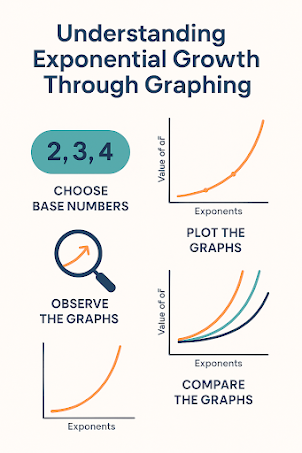Class 8 NCERT bridge course Answers Activity W 5.6 Watch It Rise: Exploring Exponent Graphs
Activity W 5.6
Students may be engaged in identifying and continuing patterns related to the exponents of a number. They may plot the graphs and check for themselves how much the graph rises with larger exponents.
Objective:
Students will investigate how exponential functions behave by plotting the powers of different base numbers. They will visually observe the pattern of exponential growth and compare how different bases grow over time.
Material Required
Rulers or measuring tools.
Procedure
Plot the values of each exponent of numbers, such as, 2, 3, 4 on a graph paper.
Plot exponents (0, 1, 2, 3, etc.) on the horizontal axis and the corresponding values 2n, 3n, 4n etc., on the vertical axis.
Students may be asked to observe the shape of the graph.
For some bases, it will be a smooth curve that grows slowly at first and then rapidly.
They may observe the pattern in which the graphs grow and explain it.
They may tell in which it was the steepest and why.
Exponent versa corresponding values.
Choose Base Numbers
Select base numbers such as 2, 3, and 4.-
Create a Table of Values
For each base number, compute the value of:a where n = 0 , 1 , 2 , 3 , 4 , 5 Example for base 2:
-
-
Plot the Graphs
-
Place exponents (n = 0, 1, 2, ...) on the x-axis
-
Place the values of on the y-axis
-
Plot the points for each base and connect them smoothly
-
-
Observe the Graphs
-
Note how the curves grow
-
Identify which graph is the steepest and discuss why
-
Compare the curves of different bases
-
-
Extension (Optional):
Plot values of fractional bases (e.g., 0.5, 1.5) and negative exponents (e.g., )
Reflections – Sample Student Answers
Following questions may be discussed:
How do the numbers increase with each step?
-
The values increase multiplicatively, not additively.
-
With each step, the number is multiplied by the base again, which leads to rapid growth.
-
-
Plot graphs for exponents of numbers which are fractions or negative numbers.
-
For a base like 0.5:
-
, ,
-
The graph decreases with increasing exponent.
-
-
For negative exponents:
-
, , etc.
-
The graph approaches zero but never touches it.
-
-
-
Which base grows the fastest and slowest?
-
Base 4 grows the fastest: its curve is steepest.
-
Base 2 grows slower compared to 3 and 4.
-
Fractional bases decrease over time.
-
The greater the base, the faster the growth.
-
-
How are exponents used in real life?
-
Computing power: Moore’s law suggests computing power doubles every 2 years → exponential growth.
-
Population growth: Under ideal conditions, populations grow exponentially.
-
Interest rates: Compound interest involves exponential growth of money.
-
Physics and Chemistry: Radioactive decay and reactions follow exponential models
(for example, computing power, population growth models, interest rates, etc.)
-



No comments:
Post a Comment